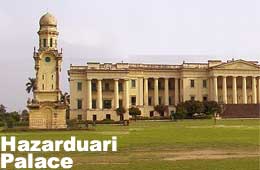| India Profile » Monuments and Temples in India » Murshidabad | |
Murshidabad | |
 | |
|
Murshidabad has witnessed treachery and palace politics, which finally resulted in passing off of Bengal into the hands of the East India Company. Siraj-ud-Daulah was the last independent Nawab of Bengal. In 1757 AD, a conspiracy between the Company and his uncle Mir Jafar led to defeat of his forces by the Company troops in the battle of Plassey. He was later murdered in Murshidabad. Mir Jafar, who betrayed Siraj became the new puppet Nawab. The East India Company reigned from here after the battle till they shifted their capital to Calcutta. The Hazar Dwari Palace or the Palace with Thousand Doors is probably the chief attraction of Murshidabad. Duncan McLeod of the Bengal Engineers built the palace for the Nawabs of Bengal in 1837 AD. The palace took 17 years to build, which has been converted into a museum today. It has 114 rooms and 8 galleries. The museum has various works of art including an exquisite collection of armory, splendid paintings, exhaustive portraits of the Nawabs beautiful works of ivory from Murshidabad School, China (European) and many other valuables. The Armory has 2700 arms in its collections out of which only few are displayed. Swords used by Siraj-ud-Daulah and his grandfather, Nawab Ali Wardi Khan, can be seen here. The other attractions in this floor are the Vintage cars and cars used by the Nawabs and their families. Nawab Murshid Quli Khan built the Katra Masjid in 1724 AD. It is modeled on the lines of the Mecca mosque. It is one of the most important tourist attractions. The gorgeous building has huge domes and high minarets. The tomb of Murshid Quli Khan is also in this mosque. The Jahankosh is a huge cannon built by Janardhan Karmakar in Decca. It is 17.5 ft long and 16,880 lbs in weight and is a major attraction for the tourists. The Nimak Haram Deorhi or the Traitor's Gate is the place where Siraj-ud-Daulah was assassinated. His grave is at Khusbagh or the Garden of Delight along with the tomb of his wife and the grave of Nawab Ali Wardi Khan. Kathgola has the ruins of the garden house of Jagat Seth, one of the co-conspirators against Siraj. Parallel to the north face of the Hazar Dwari Palace is the Nizamat Imambara. It was built in 1847 AD by Nawab Nazim Mansoor Ali Khan Feradun Jah, son of Humayun Jah, at a cost of more than 6 lacs, after the Imambara built by Siraj-ud-Daulah had been destroyed by fire. It took only eleven months to construct this Imambara. The Imambara is the largest in Bengal and one the largest in India. Wasef Manzil is a palace built by Sir Wasef Ali Mirza, Nawab of Murshidabad as his residence. This palace is very near to the South Gate of the Hazar Dwari Palace. The staircases made of marble and beautiful statues of this Palace are worth seeing. The skill of gifted craftsmen can be seen at the Khagra Bazaar. But sandalwood etching has become more popular than ivory carving. Murshidabad is famous for brass and bell metal ware, for traditional Bengali muslin and silk weaves, brocades and Jamdanis. Azimganj and Khagraghat produce excellent Bengali sweets, especially 'khaja' made with lemon, sesame seeds and sugar. |
|
 |
 Murshidabad, the last capital city of independent Bengal, is situated on the banks of the Ganges River. The district Murshidabad got its present name in the first half 18th century and its present shape in the latter half of the 18th century. The history of the district dates back to the pre-historic period as early as c.1500 BC. The capital city of Sasanka, the king of Gouda in the 7th century AD and of Mahipala, one of the later Pala kings of Bengal, was in this district too. The city was named after the Nawab of Bengal, Murshid Quli Khan who was a Brahmin who worked in the Mughal army, till Emperor Aurangzeb made him the Nawab of Bengal in 1706 AD. He made Murshidabad the capital city of Sube Bangla, which comprised of Bengal, Bihar and Orissa in 1705 AD.
Murshidabad, the last capital city of independent Bengal, is situated on the banks of the Ganges River. The district Murshidabad got its present name in the first half 18th century and its present shape in the latter half of the 18th century. The history of the district dates back to the pre-historic period as early as c.1500 BC. The capital city of Sasanka, the king of Gouda in the 7th century AD and of Mahipala, one of the later Pala kings of Bengal, was in this district too. The city was named after the Nawab of Bengal, Murshid Quli Khan who was a Brahmin who worked in the Mughal army, till Emperor Aurangzeb made him the Nawab of Bengal in 1706 AD. He made Murshidabad the capital city of Sube Bangla, which comprised of Bengal, Bihar and Orissa in 1705 AD.